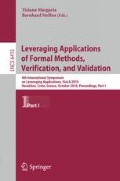Abstract
Understanding IT organization is essential for ensuring a successful transformation phase in IT outsourcing deals. We present a model of IT organization, a methodology for deriving it – based both on ethnography and data mining - and a suite of tools for representing and visualizing the model, and to help design changes to bring the organization from its current (AS-IS) state to a desired (TO-BE) state, along with tools for comparing models of organizations based on qualities and characteristics that are expected to have a bearing on the success of the IT transformation step.
Access this chapter
Tax calculation will be finalised at checkout
Purchases are for personal use only
Preview
Unable to display preview. Download preview PDF.
References
Alexander, I., Robertson, S.: Understanding project sociology by modeling stakeholders. IEEE Software 21(1), 23–27 (2004)
Beyer, H., Holtzblatt, K.: Contextual Design: Defining Customer-Centered Systems. Morgan Kaufmann Publishers, Inc., San Francisco (1998)
Brennan, K.: A Guide to the Business Analysis Body of Knowledge (Babok Guide), p. 29. International Institute of Business Analysis (2009) ISBN 0981129218
Carroll, J.M., Mack, R.L., Robertson, S.P., Rosson, M.B.: Binding Objects to Scenarios of Use. International Journal of Human-Computer Studies 41, 243–276 (1994)
Cross, R.L., Parker, A.: The Hidden Power of Social Networks: Understanding How Work Really Gets Done in Organizations. Harvard Business Press, Boston (2004)
Cysneiros, L.M.: Requirements Engineering in the Health Care Domain. In: RE 2002, pp. 350–356 (2002)
D’Souza, D.F., Will, A.C.: Objects, Components and Frameworks With UML: The Catalysis Approach. Addison-Wesley, Reading (1999)
Andrews, D.C.: JAD: A crucial demension for rapid applications development. Journal of Systems Management, 23–31 (March 1991)
Goguen, J., Linde, C.: Techniques for Requirements Elicitation. In: First International Symposium on Requirements Engineering, p. 152. IEEE Computer Society Press, Los Alamitos (1993)
Hertzum, M.: The importance of trust in software engineers’ assessment and choice of information sources. Information and Organization 12, 1–18 (2002)
Hertzum, M., Andersen, H.H.K., Andersen, V., Hansen, C.B.: Trust in information sources: seeking information from people, documents, and virtual agents. Interacting with Computers 14, 575–599 (2002)
Holtzblatt, K., Wendell, J.B., Wood, S.: Rapid Contextual Design: A How-to guide to key techniques for user-centered design. Morgan Kaufmann Publishers, Inc., San Francisco (2005)
Hughes, J., O’Brien, J., Rodden, T., Rouncefield, M., Sommerville, I.: Presenting ethnography in the requirements process. In: Second IEEE International Symposium on Requirements Engineering, RE 1995, p. 27 (1995)
Jahn, K., Lawson, R.: Transforming IT: A Five-Step Plan for Adopting a Service Centric IT Model, Barrios (2009)
Kolodner, J.L., Leake, D.B.: A Tutorial Introduction to Case-Based Reasoning. In: Leake, D.B. (ed.) Case-Based Reasoning: Experiences, Lessons, and Future directions. The MIT Press, AAAI Press, Cambridge, MA (1996)
Krackhardt, D., Carley, K.M.: A PCANS Model of Structure in Organizations. In: 1998 International Symposium on Command and Control Research and Technology, Monterey, CA (1998)
Krackhardt, D., Hanson, J.R.: Informal Networks: The Company Behind the Chart. Harvard Business Review 71(4), 104–111 (1993)
Leake, D.B.: CBR in Context: The Present and Future. In: Leake, D.B. (ed.) Case-Based Reasoning: Experiences, Lessons, and Future directions. The MIT Press, AAAI Press, Cambridge, MA (1996)
Leite, J.C.S.P., Franco, A.P.M.: A Strategy for Conceptual Model Acquisition. In: Proceedings of the First IEEE International Symposium on Requirements Engineering, pp. 243–246. IEEE Computer Society Press, SanDiego (1993)
Lim, S.L., Quercia, D., Finkelstein, A.: StakeSource: harnessing the power of crowdsourcing and social networks in stakeholder analysis. In: Proceedings of the 32nd ACM/IEEE international Conference on Software Engineering, ICSE 2010, Cape Town, South Africa, May 01 - 08, vol. 2, pp. 239–242. ACM, New York (2010)
Miles, S., Groth, P., Deelman, E., Vahi, K., Mehta, G.: Provenance: The Bridge Between Experiments and Data. In: Computing in Science & Engineering, pp. 38–46 (May/June 2008)
Moser, C., Kalton, G.: Survey Methods in Social Investigation. Gower, England (1971)
Non-Functional Requirements into data model. In: 4th International Symp. on Requirements Engineering (June 1999)
Randal, D., Hughes, J., Shapiro, D.: Steps toward a partnership: Ethnography and system design, Draft, Lancaster University (1992)
Socio-Technical Systems at University of Saint Andrew: Ethnography, http://miud.in/92E
Sommerville, I.: Notes, http://miud.in/92D
Sommerville, I.: Requirements Engineering. John Wiley and Sons, Chichester (1998)
Tseng, S., Fogg, B.J.: Credibility and computing technology. Communications of the ACM 42(5), 39–44 (1999)
Author information
Authors and Affiliations
Editor information
Editors and Affiliations
Rights and permissions
Copyright information
© 2010 Springer-Verlag Berlin Heidelberg
About this paper
Cite this paper
Bartolini, C. et al. (2010). Understanding IT Organizations. In: Margaria, T., Steffen, B. (eds) Leveraging Applications of Formal Methods, Verification, and Validation. ISoLA 2010. Lecture Notes in Computer Science, vol 6415. Springer, Berlin, Heidelberg. https://doi.org/10.1007/978-3-642-16558-0_41
Download citation
DOI: https://doi.org/10.1007/978-3-642-16558-0_41
Publisher Name: Springer, Berlin, Heidelberg
Print ISBN: 978-3-642-16557-3
Online ISBN: 978-3-642-16558-0
eBook Packages: Computer ScienceComputer Science (R0)

